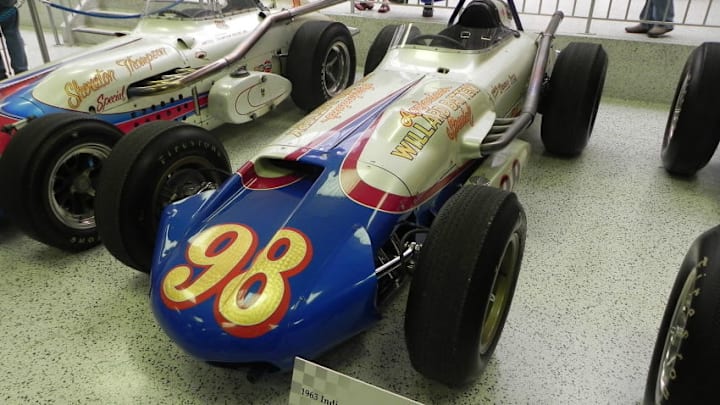While I have been researching the history of the Indy 500 as we approach the 100th running, I noticed something. The cars used to be the stars, maybe it’s time to let that happen again.
It has been so much fun watching the specials about the historic races at Indy leading up to this years running of the 500. Most of the classic races have something that is missing today, innovation. Someone would come out with a new car, something radically different that would attract attention. In some cases it would be a success, others absolute failures.
Just going through the names of some of the cars brings imagery of beautiful machines and their brave drivers. The 1911 Marmon Wasp, Lou Moore’s Blue Crown Special, Penske PE23, Belond Exhaust Special, Lotus 38, Maserati 8CTF, STP Pratt and Whitney Turbine and Dan Gurney’s Eagle. I literally could fill the page with the great names of Indy cars. It was exciting to see what teams were going to bring to the brickyard to race on any given year.
Then under the banner of “controlling costs” IndyCar has gone to a common chassis, the Dellara. When you read how the deal came together for the Dellara chassis to be used, its sounds of a deal struck in congress that makes you sick. There were tax breaks for building them in Indiana, set prices to control costs. None of those sound like what makes for great innovation or pushing the envelope on the track.
I was reading that the Dellara chassis 2011 winner Dan Weldon drove to victory was actually built in 2003 and had been raced by several different teams. What racing series in the world would have a car that is 8 years old as one of its best? There is a celebration when new F1 cars are introduced, the worlds most popular racing series. IndyCar racing used to be as much about the car as it was the driver in the seat. Some of the most famous drivers in Indy racing history became such by being in the right car at the right time.
The rules package that Indy has boxed he teams into has all but eliminated any chance for teams to innovate. They raced a turbine engine at the brickyard in 1967 for heavens sake. Now the teams have to run a 2.2l twin turbo engine leased from only two builders. If it is not a Chevrolet then as of this moment, you are not going to have a chance to win. Where is the excitement in that?
Yes the designers would have built motors far too powerful for the speedway if left to there own devices. The rules could always be put into place to limit the power capabilities without totally handcuffing the teams. Same goes with the cars themselves, let the designers go a little crazy and bring some identity to them. When you look at the pictures of the winners over the decades you can get within a year or two when guessing when they ran. Now you look at pictures of the cars over the last decade, without looking it up you would have almost no idea when they ran.
The history of Indy is written by the designers who were bold enough to try new things. In 2016 it is all about the strategy and the engine lease agreement. The term legendary is used when describing car builders and designs in Indy lore. What in todays Indy do you think will be described in such colorful terms. This very well could be described as the spec era of Indy racing, and that is not a good thing.
Most forms of racing have worked hard to make the competition closer in the hopes of creating exciting racing. In this era we have seen the popularity of NASCAR and IndyCar suffer because of it. Yes fans want to see close racing, but not artificially close racing. It’s a mistake that has cost both series fans that they have come to recognize. We have seen IndyCar try to introduce aero kits to give a more identifiable look to the cars.
More racing: Indy 500 Shaping Up To Be A Star-Studded Event
What the powers in IndyCar and other racing series never understood is that there is a group of fans that used to follow the sport for the innovation. They were the geeks, like me, that were excited to hear what the cars were going to sound like or what the new wing was going to look like. The shape of the intake ducts to create downforce while reducing drag. It was a lesson in engineering from my couch every May watching the cars as they sat in the pits.
Those days are gone, in favor of lower costs and pack racing. The issue is, when you look back some of the greatest innovators did not have the biggest pocketbook, they had the biggest ideas. Right now ideas have been legislated out of Indy and that is a big part of the history of the sport. If IndyCar ever hopes to regain some of the popularity it once had, its going to need to bring back the dreamers. Not just the engineers, but the fans on the couch that can’t wait to see what hits the track.
